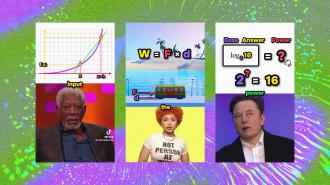“Hey, you!” Kim Kardashian yells through your smartphone’s speakers. “Draw out this function on a graph for me.” On the screen, a function appears against a white background. Kim explains it.
Then Jordan Peterson gets into the mix. “When x is zero, x squared is also zero,” he says, doing the same for a table of values. It all seems like a fever dream, but attentive viewers might be on their way to graphing functions in the time of a TikTok.
The real Kim Kardashian and Jordan Peterson aren’t in the business of publishing short-form educational math videos on social media. That’s Kabir Knupp’s job. As a 23-year-old London-based data engineer with experience in tutoring, Kab runs the channel Onlock Learning, where he uses Parrot AI to generate deepfake videos of celebrities explaining basic concepts in math, physics, and engineering.
With sleek editing, simple language, and a relatable vibe, Kab’s videos have racked up millions of views and a shout-out from Elon Musk, whose likeness Kab replicated in a video where the tech mogul explains logarithms.
Kab had the idea for Onlock Learning while scrolling through “brain rot” content on YouTube Shorts. He wondered: “If we’re watching brain rot […] and really random stuff that maybe doesn’t give you any knowledge value, is there a way to kind of merge it so that you actually do get […] valuable content?”
So he landed on a simple plan: Take the attention-grabbing strategies that make brain-rot content virtually irresistible and use them to package educational content. For example, his videos use quick cuts, background music, subtitles (which give your eyes something to lock on to, Kab noted), and, of course, AI-generated celebrities.
“Those things just really get you fixated on [the content] and make it super easy to watch,” Kab told Freethink.
He initially planned to make AI-generated celebrities a small part of his strategy. After all, one friend had told him that having conversations with AI Eminem, Donald Trump, or Ariana Grande might be a bit tacky. But then one of his deepfake videos — featuring him speaking with Santa Claus and Buddy the Elf on Christmas Eve — went viral. “It was good validation for my whole idea,” Kab said.
Kab’s not quite sure why AI celebrity tutors are so popular. Maybe it’s that there’s something immediately captivating about celebrities playing against type: It’s surprising and funny to see someone like Ariana Grande or Donald Trump explaining a logarithm or an indefinite integral, similar to how it’s funny and disarming to see Will Ferrell — a grown man with an NFL player’s build — wear yellow tights as Buddy the Elf.
But are viewers really learning from the videos, or is this mostly just a fun gimmick? After all, attention-grabbing strategies like quick edits and familiar faces might be good for hooking viewers, but these devices might also be distracting. Kab seemed to agree. “[My strategy is] definitely not as effective as if someone did find the concentration span” to learn in more conventional ways, with textbook, pen, and paper.
Still, some viewers said they’re learning from the videos.
“Bro’s explanation is better than my teacher,” wrote one commenter. “Understanding it after i failed maths,” wrote another. One suggested: “This may be the best use of generative AI that presently exists.”
Without empirical data, it’s difficult to know how effective this type of strategy is in helping viewers grasp and retain educational content. But Kab suggested the main function of his videos is to get people interested in exploring deeper concepts in math, physics, and engineering.
“It’s a good start because it brings people to it and keeps them on there,” he said. “If your brain’s already rotted from social media and you can’t get off it, in my opinion, it’s a good segue to get back into [learning].”
Kab plans to expand his online education offerings into a gamified project, one that keeps the general vibe of his short-form videos but ditches the AI celebrities. He predicts AI will soon enable all sorts of new ways to learn, such as video-game worlds populated with computer-generated characters with whom you can have real-time conversations about complex topics.
How effective such teaching techniques will be remains an open question. But Kab’s approach to online teaching raises a valid question about the future of education: “It’s young people learning this stuff, mainly, so why is none of the content, or the way it’s delivered, designed or tailored to young people?”






